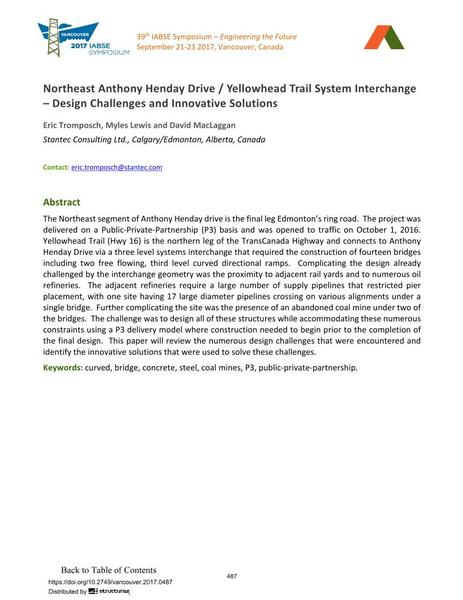Northeast Anthony Henday Drive / Yellowhead Trail System Interchange

|
|
|||||||||||
Bibliografische Angaben
| Autor(en): |
Eric Tromposch
(Stantec Consulting Ltd., Calgary/Edmonton, Alberta, Canada)
Myles Lewis (Stantec Consulting Ltd., Calgary/Edmonton, Alberta, Canada) David MacLaggan (Stantec Consulting Ltd., Calgary/Edmonton, Alberta, Canada) |
||||
|---|---|---|---|---|---|
| Medium: | Tagungsbeitrag | ||||
| Sprache(n): | Englisch | ||||
| Tagung: | IABSE Symposium: Engineering the Future, Vancouver, Canada, 21-23 September 2017 | ||||
| Veröffentlicht in: | IABSE Symposium Vancouver 2017 | ||||
|
|||||
| Seite(n): | 487-495 | ||||
| Anzahl der Seiten (im PDF): | 9 | ||||
| Jahr: | 2017 | ||||
| DOI: | 10.2749/vancouver.2017.0487 | ||||
| Abstrakt: |
The Northeast segment of Anthony Henday drive is the final leg Edmonton’s ring road. The project was delivered on a Public-Private-Partnership (P3) basis and was opened to traffic on October 1, 2016. Yellowhead Trail (Hwy 16) is the northern leg of the TransCanada Highway and connects to Anthony Henday Drive via a three level systems interchange that required the construction of fourteen bridges including two free flowing, third level curved directional ramps. Complicating the design already challenged by the interchange geometry was the proximity to adjacent rail yards and to numerous oil refineries. The adjacent refineries require a large number of supply pipelines that restricted pier placement, with one site having 17 large diameter pipelines crossing on various alignments under a single bridge. Further complicating the site was the presence of an abandoned coal mine under two of the bridges. The challenge was to design all of these structures while accommodating these numerous constraints using a P3 delivery model where construction needed to begin prior to the completion of the final design. This paper will review the numerous design challenges that were encountered and identify the innovative solutions that were used to solve these challenges. |
||||
| Stichwörter: |
Stahl Beton Brücke
|
||||
